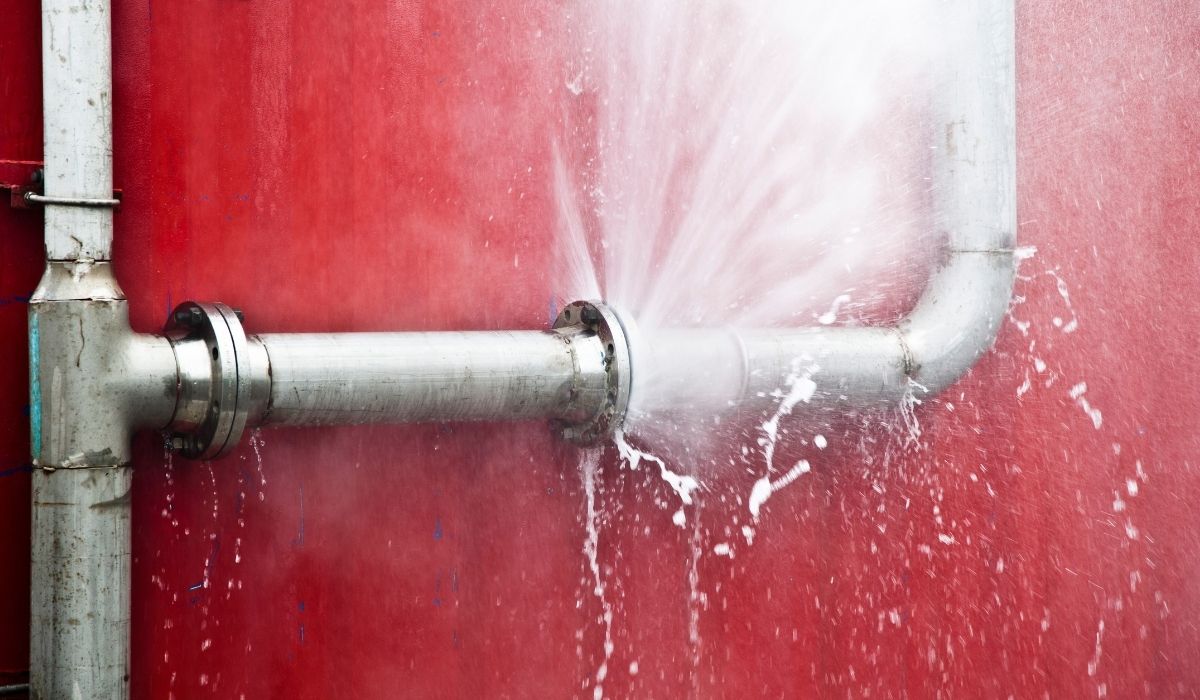Effective Methods for Drying Water Damage in Your Basement
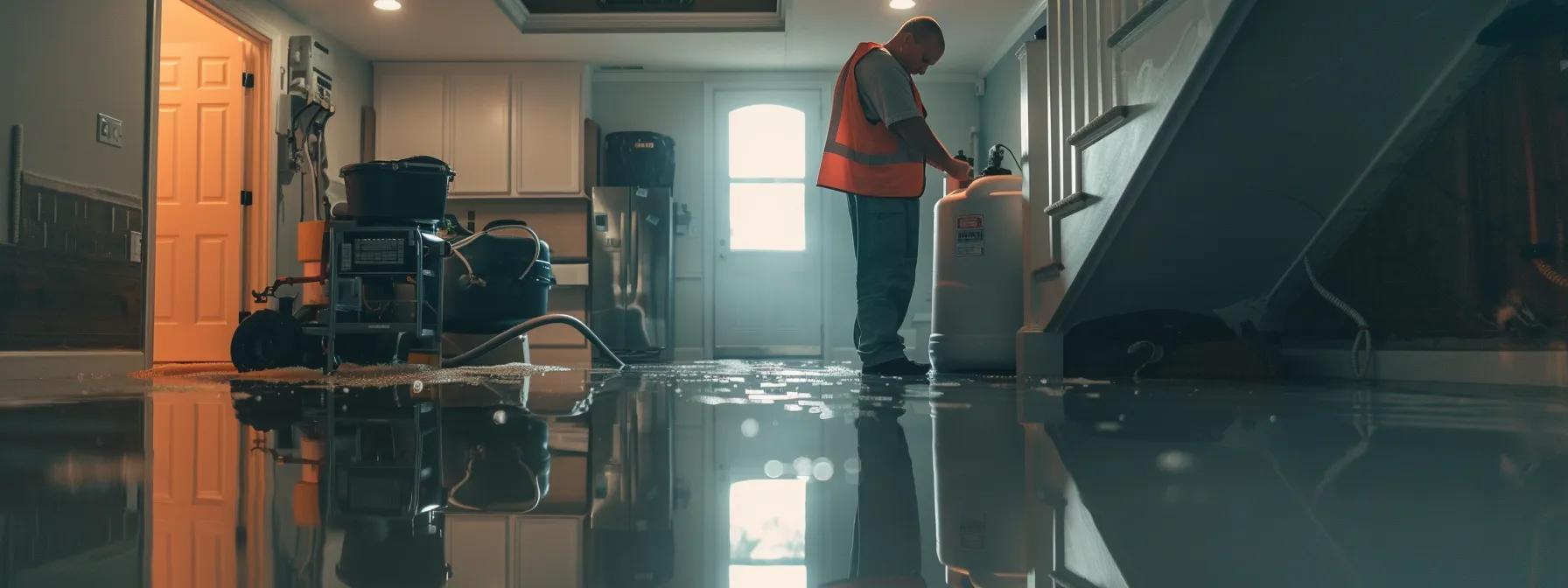
Water Damage in Basements: How to Dry and Repair Quickly
Basement water damage is a critical issue that not only compromises the structure of a home but also creates a breeding ground for mold, bacteria, and other hazards. Homeowners facing water intrusion in their basement must quickly understand the risks and implement proper drying and repair methods. This comprehensive guide is designed to help readers address flooded basements with practical techniques, expert advice, and scientifically backed strategies. It highlights the importance of proper drainage, waterproofing, and maintenance; considerations such as electrical safety; and the need for professional help when the damage becomes extensive. Homeowners will gain insights into choosing the right equipment—from dehumidifiers to submersible pumps—and learn how to inspect for hidden moisture pockets and structural issues. In addition, the article delves into effective repair strategies, underlining the importance of addressing issues at the source, whether that be foundation cracks or faulty sump pumps. By incorporating tips on prevention and routine inspections, readers will leave with the knowledge they need to protect their investment while ensuring a safe and dry environment. As the article unfolds, each major section provides actionable steps, supported by peer-reviewed studies and detailed lists and tables that break down complex technical guidelines into manageable tasks. This guide serves as a valuable resource for anyone looking to restore or safeguard their basement from water damage and mold hazards.
Transitioning now to actionable solutions, the following sections break down the process into five distinct phases: immediate water removal, thorough drying, damage assessment, repair strategies, and prevention. Each section is explained in detail under its respective headings to ensure you can quickly and safely address the situation.
Swift Basement Water Removal Actions to Minimize Damage
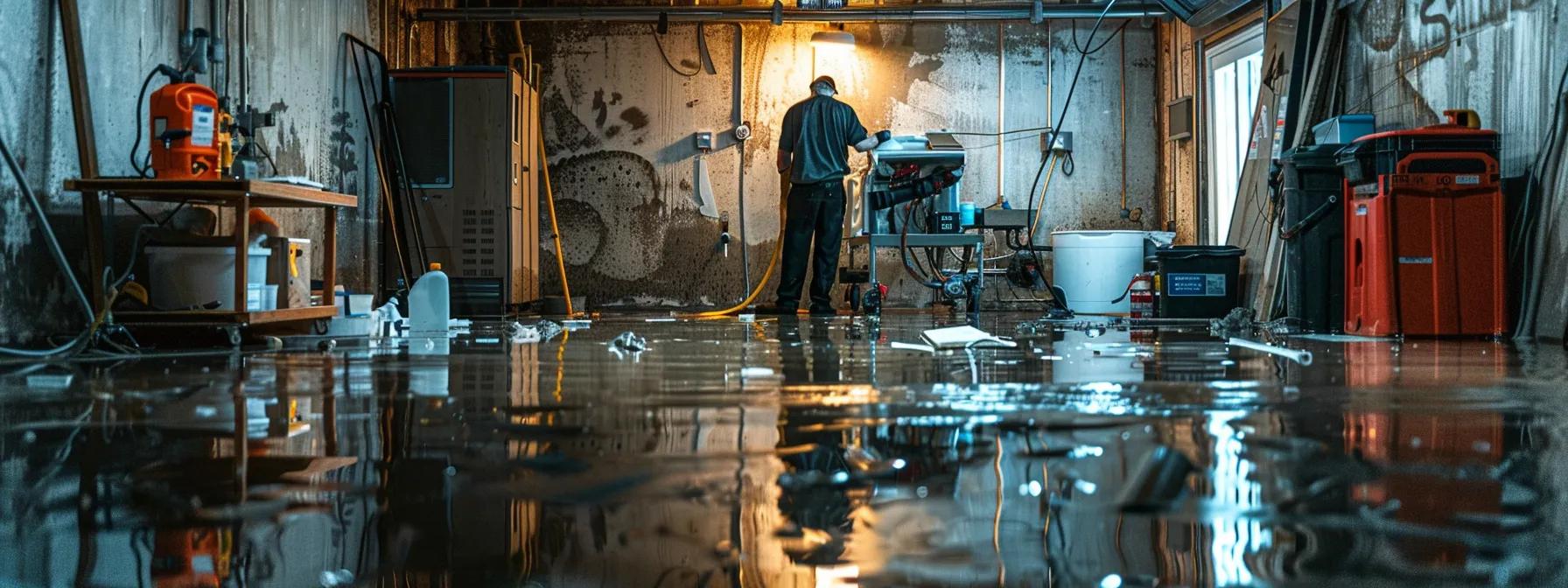
When water starts invading a basement, the first priority is to remove the standing water quickly and safely. Immediate action is necessary to reduce further structural damage, mold growth, and potential electrical hazards. The initial step is safely entering your flooded basement. This involves evaluating risks such as the presence of electrical wiring and ensuring that all power sources are turned off to prevent electrocution. Homeowners should use waterproof gear, such as boots and gloves, and check for any signs of mud, debris, or chemical contaminants that might be present.
Once it is safe to enter, the next step is to identify the water source and halt further intrusion. This could involve finding leaks near the foundation, blocked drainage systems, or malfunctioning sump pumps. Knowing the cause helps prevent additional water damage and informs the repair strategy later in the process. For example, if the water is coming from an external source due to poor drainage, steps must be taken to improve the drainage system such as cleaning out storm drains or regrading the landscape.
Essential tools for basement water removal include a submersible pump, shop vac, buckets, and mops. These tools assist in extracting standing water effectively. A submersible pump is ideal for removing large volumes of water, while a shop vac can help with residual puddles and moisture extraction from carpets and hard floors. Additionally, using a water leak sensor can help monitor remaining water accumulation during and after the removal process.
Methods for extracting standing water depend on the severity of the flooding. In cases of minor flooding, manual removal using towels and a vacuum may suffice. However, extensive damage requires heavy-duty pumps that can remove water quickly to minimize exposure. Homeowners should always be cautious around electricity; having a qualified electrician inspect any residual risk once water exposure has subsided is crucial.
Contacting professionals for emergency basement water removal is advised if the flooding is severe. Experts have the necessary equipment, such as industrial-grade pumps and dehumidifiers, and are trained to manage associated electrical and mold hazards. By immediately dealing with the water, the overall damage can be significantly reduced, lessening repair costs and restoration time.
Key Takeaways: – Safely enter the flooded basement by switching off electricity and using protective gear. – Identify the water source to prevent further intrusion. – Use appropriate tools like submersible pumps and shop vacs to remove standing water effectively. – Contact professionals if flooding is extensive to manage associated hazards.
Mastering Techniques for Drying Flooded Basements Thoroughly
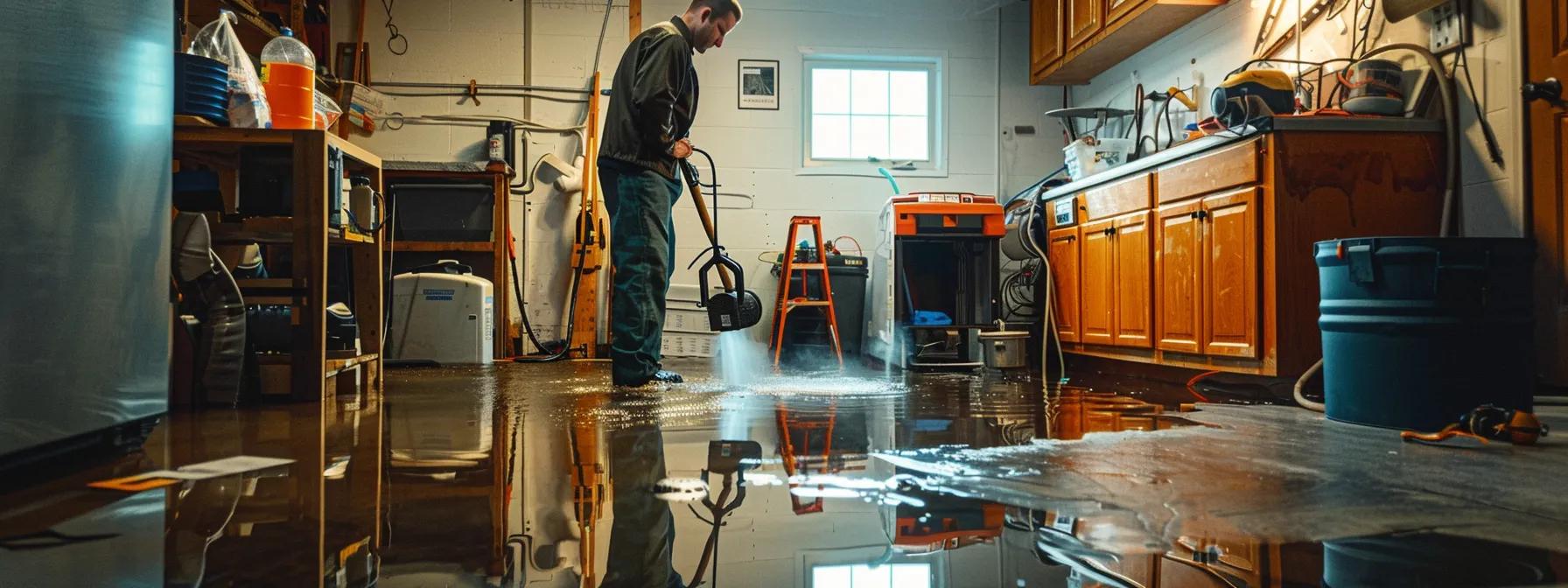
After removing the standing water, the next critical step is thoroughly drying the basement. Proper drying prevents mold, mildew, and structural decay. The process begins with setting up air movers—industrial fans designed to circulate air and increase evaporation. These devices create constant airflow across wet surfaces, accelerating the drying process even under humid conditions. For optimal airflow, homeowners should position air movers at strategic points to cover all areas of the basement.
Using dehumidifiers is equally vital to reduce basement moisture. Dehumidifiers extract moisture from the air, lowering humidity levels to prevent condensation on walls, floors, and personal belongings. In an enclosed underground space, lowering the humidity to below 50% is ideal. Professional advice and peer-reviewed studies have shown that operating a dehumidifier continuously for 48–72 hours can reduce moisture levels by up to 40%, contributing to a faster restoration of the space. For instance, a study published in the Journal of Building Engineering (2018, available at https://doi.org/10.1016/j.jobe.2018.04.012) demonstrated that controlled dehumidification reduced the relative humidity significantly, thereby minimizing mold spore proliferation.
Checking for hidden moisture pockets is an essential part of the drying process. Moisture meters and infrared cameras are tools that can detect damp areas behind walls, floors, or ceilings which might remain undetected to the naked eye. These pockets of moisture, if left untreated, can lead to persistent water damage and mold growth months after the initial flooding.
In addition to mechanical drying, natural ventilation strategies play a supportive role. Opening windows and doors, when outdoor conditions permit, can help exchange moist indoor air with drier outside air. However, this method works best as a supplementary technique, especially in climates where outdoor air quality and humidity are challenging. Combining both industrial and natural methods ensures a more comprehensive drying process.
Before moving on to repairs, it is crucial to monitor the basement’s drying progress. Homeowners should document moisture levels periodically using sensors and meters. This documentation not only confirms that the drying process is effective but also provides necessary records for insurance claims and future inspections.
Key Takeaways: – Air movers are essential for circulating air and promoting evaporation. – Dehumidifiers are critical to reducing ambient moisture levels and preventing mold growth. – Detect hidden moisture pockets with moisture meters and infrared cameras. – Utilize natural ventilation as a supplementary drying method. – Continuous monitoring ensures effective drying and provides documentation for insurance.
Assessing the Scope of Basement Water Damage
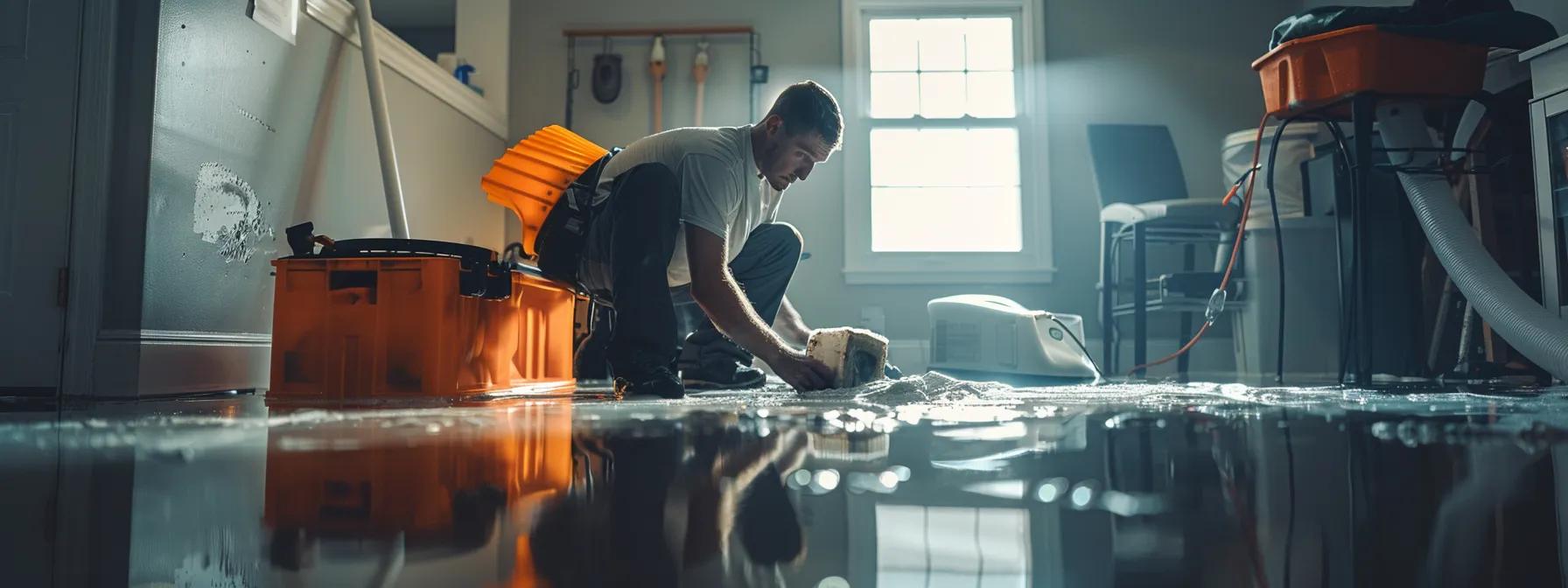
A thorough assessment of the water damage is necessary once the basement is dry. This evaluation helps determine the extent of structural damage, identify areas affected by mold, and plan proper repairs. The first step is inspecting structural components for integrity. This involves checking the foundation, support beams, and load-bearing walls for cracks or signs of water penetration. Any deterioration in these components could compromise the safety of the structure and may require immediate professional repair. Homeowners are advised to look for discolorations, efflorescence (a white, powdery residue), and noticeable shifts in the building’s structure that indicate water damage.
Identifying damage to walls and flooring is equally important. Water can weaken drywall and carpet as well as cause tiles to lift or warp. In severe cases, the water may have infiltrated insulation materials or wood panels, which could lead to long-term problems such as mold growth or material rot. Detailed inspections often reveal that areas which appear intact on the surface hide significant internal damage, necessitating more invasive repairs like replacing drywall or the underlying insulation.
Checking for mold growth after basement flooding is critical, given that mold begins to develop within 24 to 48 hours under moist conditions. Visible mold often appears as patches of discoloration, typically green, black, or white in color, spreading over surfaces where water has accumulated. Apart from aesthetic concerns, mold can be hazardous to health, causing respiratory problems and allergic reactions. In this phase, using a moisture meter and other detection tools can help pinpoint hidden mold infestations that might not be immediately visible.
Evaluating damage to personal belongings is also part of the comprehensive damage assessment. Furniture, stored items, and personal files may have suffered water damage. Items such as upholstery, carpets, and wooden furnishings are particularly vulnerable. It is essential to document all damage, both for repair purposes and for insurance claims. Photographs and written records can serve as evidence during the insurance claim process, helping to recover costs for restoration and replacement.
Documenting damage for insurance claims is a critical final step in this phase. Homeowners must create a list of damaged areas and items, accompanied with supporting photographic and written evidence. This documentation not only facilitates a smoother claims process but also provides a clear roadmap for the necessary repairs. A detailed damage assessment can be organized into a table for clarity, allowing the homeowner to track each damaged element and the estimated repair or replacement cost.
Below is an example table summarizing the key elements of damage:
| Component | Damage Observed | Estimated Repair Cost | Urgency Level | Notes |
|---|---|---|---|---|
| Foundation | Cracks and efflorescence | High | Immediate | Professional evaluation required |
| Drywall | Discoloration, soft spots | Medium | High | Possibly replace affected sections |
| Flooring (Carpet/Tiles) | Warping, lifting | Medium | Medium | Partial replacement needed |
| Structural Beams | Minor water staining | Low | Low | Monitor for further signs |
| Personal Belongings | Water-soaked upholstery, documents | Variable | Medium | Document thoroughly for insurance claim |
Key Takeaways: – Inspect structural components to ensure the integrity of the foundation and support beams. – Evaluate walls, flooring, and hidden areas for signs of water damage. – Use moisture detection tools to identify mold growth. – Document all damage accurately to assist with insurance claims. – A structured table helps in tracking damage and repair costs.
Effective Basement Water Damage Repair Strategies

Repairing water-damaged basements requires a strategic approach that addresses both the immediate and underlying issues. A systematic repair strategy begins with repairing foundation cracks and sealing leaks. Cracks in the foundation not only allow water to seep in but can also undermine the structural integrity of the home. Epoxy injections, hydraulic cement, and waterproof sealants are often employed to close these cracks. Specialized products, such as polyurea coatings, provide durable water resistance and create an effective vapor barrier that prevents further moisture penetration. Homeowners may consult with structural engineers to ensure that these repairs meet local building codes and safety standards.
Replacing damaged drywall and insulation is the next essential step. Water-damaged drywall can become a hotbed for mold and can lose its load-bearing capabilities, while wet insulation loses its thermal properties and may also promote mold growth. The repair process generally involves removing all affected drywall and replacing it with new material, then insulating with moisture-resistant options, such as closed-cell spray foam. In areas where mold is present, using anti-microbial treatments during the replacement process is crucial to ensure a safe environment.
Flooring repair and replacement options after water damage vary depending on the material. For instance, carpeted areas may require complete removal and replacement, while hardwood floors may be sanded and refinished if the damage is superficial. Tile floors that have come loose might need re-grouting and adhesion reinforcement. In some cases, water-damaged subfloors must be replaced to provide a stable base for new flooring. Repair or replacement of flooring is a significant part of the restoration process and directly influences the basement’s appearance and functionality.
Addressing electrical system damage safely is an often-overlooked step in water-damaged basements. Water intrusion can cause significant harm to electrical wiring and electrical panels, potentially leading to short circuits or even electrical fires. It is imperative to have a qualified electrician inspect all electrical installations after a flood. Damaged wiring should be replaced entirely, and circuit breakers need to be tested to ensure they activate properly during emergencies. Safety protocols may include turning off electricity at the main service panel during inspections and repairs to prevent shock hazards.
Mold remediation steps for a healthy basement are equally crucial in the repair strategy. Even after drying and disinfecting, mold spores may persist in hidden areas. Remediation involves applying fungicidal treatments to affected surfaces, using EPA-approved disinfectants, and sometimes even employing ozone treatments to sanitize hard-to-reach areas. Homeowners should consider hiring professional mold remediation specialists if the affected area is extensive or if the occupants have respiratory sensitivities.
A comprehensive repair strategy is best understood when broken down into detailed lists. Consider the following list of key steps involved in basement repair after water damage:
- Foundation Repair and Sealing – Use epoxy injections and hydraulic cement to seal cracks, ensuring a durable and waterproof barrier.
- Drywall and Insulation Replacement – Remove all water-damaged drywall and insulation, then reinstall moisture-resistant materials with anti-microbial treatments.
- Flooring Restoration – Choose between sanding and refinishing for hardwood or complete replacement for carpet, ensuring a stable and attractive finish.
- Electrical System Inspection – Engage a licensed electrician to inspect and replace any damaged wiring or panels to secure the electrical system.
- Mold Remediation – Apply EPA-approved fungicides and consider professional services for extensive mold contamination to ensure a healthy living space.
Each of these steps is aimed at not only restoring the basement’s functionality but also preventing further damage and ensuring that all repairs meet safety and building standards.
Key Takeaways: – Foundation repair using epoxy and hydraulic cement is crucial to stop water intrusion. – Replace water-damaged drywall and insulation to prevent mold growth. – Flooring repair must be tailored to the type of material and extent of damage. – Electrical systems require inspection by licensed electricians for safety. – Comprehensive mold remediation protects health and ensures long-term restoration success.
Preventing Future Water Damage in Your Basement

After the water has been removed and repairs are complete, preventing future water damage is paramount to minimize the risk of recurring issues. Improving exterior drainage and grading around the foundation is a key preventive measure. Homeowners should evaluate the landscape to ensure that water flows away from the house rather than pooling around the foundation. This might involve regrading the yard, installing French drains, or even incorporating gutter extensions to carry water further away. Attention to drainage not only reduces basement water damage but also helps in managing mud and sediment buildup along exterior walls.
Installing or maintaining sump pumps is another effective prevention strategy. Sump pumps serve as the first line of defense against water accumulation in basements. Regular maintenance of these pumps, including testing the battery backup and cleaning the pit, ensures reliable performance during heavy rains or power outages. In some cases, installing a high-capacity sump pump or an additional pump may be necessary, particularly in regions prone to flooding. Ensuring proper functionality of the pump is essential, as a failed sump pump can increase the risk of significant water damage.
Waterproofing basement walls and floors is an additional critical measure. This process involves applying sealants, membranes, or coatings specifically designed to repel water. Waterproofing not only prevents seepage but also acts as a vapor barrier, reducing condensation and subsequent mold growth. Products like polyurethane and polyurea sealants are commonly used because of their durability and resistance to abrasion. Furthermore, integrating a moisture barrier beneath the flooring can protect the subfloor from long-term damage.
Managing indoor humidity levels through the use of dehumidifiers and proper ventilation is another important preventive step. Keeping humidity levels below 50% is ideal to prevent mold growth and condensation. Smart sensors, such as water leak sensors, can alert homeowners to rising humidity levels or early signs of water intrusion, allowing for prompt corrective action. Regularly running a dehumidifier during wetter months or after significant rain events can maintain a dry environment in the basement.
Regular basement inspections are essential for early leak detection. Homeowners are advised to schedule quarterly inspections to identify potential problem areas such as cracked walls, water stains, or signs of mold. Investigating these issues early can save substantial repair costs and health hazards over time. Keeping a detailed maintenance log that includes inspections, sump pump tests, and seasonal repairs can help track the basement’s condition and alert homeowners to trends that might indicate impending issues.
Below is a detailed list of preventive measures for future basement water damage:
- Improve Exterior Drainage and Grading – Regrade the yard and install proper drainage systems like French drains and gutter guards to ensure water flows away from the home.
- Install/Maintain Sump Pumps – Regularly test and maintain sump pumps, and consider a backup system to secure water removal during power outages.
- Waterproof Walls and Floors – Apply high-quality sealants and install vapor barriers to prevent water seepage and condensation.
- Manage Indoor Humidity – Use dehumidifiers and water leak sensors to monitor and control moisture levels effectively.
- Regular Inspections – Schedule routine checks to catch and repair minor issues before they escalate into major problems.
By implementing these measures, homeowners not only safeguard their property but also reduce potential repair costs and environmental hazards. Prevention is a continuous process that relies on routine maintenance and timely upgrades to the home’s drainage and waterproofing systems.
Key Takeaways: – Effective exterior drainage and proper yard grading are critical to divert water away from the home. – Regular maintenance of sump pumps and installation of backup systems can prevent significant flooding. – Waterproofing walls and floors acts as a robust barrier against water seepage. – Controlling indoor humidity with dehumidifiers and sensors prevents mold growth and condensation. – Routine inspections help identify early signs of damage, allowing for prompt repairs.
When Professional Basement Water Damage Repair Is Necessary

Even though many basement water damage issues can be addressed by DIY methods, there are circumstances where the involvement of professional repair services is essential. Recognizing extensive structural damage is the first indicator that professional help is required. When water damage affects the foundation, load-bearing walls, or support beams, the risk of catastrophic failure increases. Extensive damage may hide behind wet drywall or under the flooring, requiring sophisticated diagnostic tools like infrared cameras and advanced moisture meters that professionals typically have. Structural engineers or specialized contractors can perform a thorough analysis and implement advanced reinforcement strategies that are beyond the scope of DIY repair.
Dealing with widespread mold contamination is another situation where professional assistance is mandatory. Even if the visible mold seems confined, microscopic spores can persist throughout the structure, adversely affecting indoor air quality and posing health risks. Professional mold remediation specialists use EPA-approved protocols and advanced cleaning techniques to remove mold effectively, prevent its recurrence, and ensure that the indoor air remains safe. Their remediation process includes containment measures, HEPA filtration, and the use of anti-fungal chemicals that are not readily available to the average homeowner.
Handling sewage backup and contaminated water is another area that should always be managed by professionals. Sewage water contains not only bacteria and viruses but also hazardous chemicals that can pose serious health risks if not handled with the appropriate personal protective equipment (PPE) and sanitation protocols. Professionals in water damage repair are trained to safely remove contaminated water and dispose of hazardous waste in compliance with local regulations, thereby avoiding any potential health or legal issues.
Understanding the limitations of DIY basement water damage repair is crucial for homeowners. Although simple leaks and surface water removal are manageable, complex issues such as compromised electrical systems, extensive mold spread, and structural deteriorations require the expertise of licensed contractors. Professionals can ensure that repairs are not only effective but also compliant with building codes and safety standards. Often, insurance companies require a professional assessment and repair report to process claims, further emphasizing the necessity of expert involvement.
Finding reputable basement water damage repair services involves thorough research. Homeowners should seek agencies with proven track records, verified certifications, and positive customer reviews. Recommendations, referrals, and accredited certifications (such as those from SERVPRO or local contractor associations) provide assurance of the service quality. In many cases, professionals offer a comprehensive repair plan that covers initial damage assessment, water extraction, drying, mold remediation, and final restoration, ensuring no aspect of the damage is overlooked.
A summarized list of scenarios requiring professional intervention includes:
- Extensive Structural Damage – When foundational cracks or compromised support beams are present, professional interventions ensure structural integrity.
- Widespread Mold Contamination – Large-scale mold infestations need expert remediation and decontamination techniques.
- Sewage Backup or Contaminated Water – Due to the hazardous nature of sewage, professionals must handle cleanup and disposal.
- Electrical System Compromise – Damaged wiring and panels require a licensed electrician’s expertise.
- Complex Insurance Claims – Professional assessments provide the documentation required for processing insurance claims.
Key Takeaways: – Extensive structural damage, widespread mold, or sewage contamination necessitates professional repair. – Professionals use advanced diagnostic tools, containment measures, and remediation techniques. – Licensed experts ensure repairs meet building codes and safety standards. – Professional services facilitate smoother insurance claim processes. – Timely professional intervention can prevent long-term hazardous conditions.
Frequently Asked Questions
Q: How soon should a basement be dried after water intrusion? A: Drying should begin immediately after water removal. Ideally, dehumidifiers and air movers should be set up within 24 hours to reduce humidity and prevent mold growth.
Q: Can I repair water-damaged drywall myself? A: Minor damage may be repaired with DIY methods; however, if the drywall shows extensive mold or structural issues, professional replacement and remediation are recommended to ensure safety and long-term stability.
Q: What are the most cost-effective waterproofing methods for basements? A: Improving exterior drainage, installing a sump pump, and applying high-quality sealants are among the most cost-effective strategies. Combining these with routine maintenance can significantly reduce future water damage risks.
Q: When should I call a professional for my basement water damage issues? A: Professionals should be called when there is evidence of extensive structural damage, widespread mold contamination, or in cases of sewage backup. Also, if you are unsure about electrical safety, professional assessment is crucial.
Q: How can regular inspections help prevent basement water damage? A: Regular inspections help catch minor issues early, such as hairline cracks or slight moisture buildup, before they develop into more serious problems. Monitoring helps ensure that drainage systems, sump pumps, and waterproofing measures remain effective.
Final Thoughts
Basement water damage represents a complex challenge that calls for quick, decisive action and structured repair strategies. From immediate water removal to thorough drying, a detailed damage assessment, targeted repair, and effective prevention measures, every step plays a critical role. Homeowners must remain proactive by investing in regular inspections and professional services when necessary. Ultimately, addressing water damage promptly not only safeguards the property but also secures the health and well-being of those living in it.



